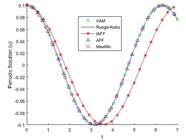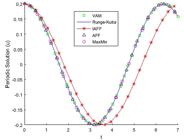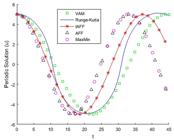Abstract
In the present study, the response of a flexible string with large amplitude transverse vibration is studied utilizing amplitude-frequency formulation, improved amplitude-frequency formulation and max-min approach. In order to verify the accuracy of these approaches, obtained results are compared with other methods such as variational approach method, variational iteration method, coupling Newton’s method with the harmonic balance method and Hamiltonian approach. It has been found that for this problem, while amplitude-frequency formulation and max-min approach give the same results, improved amplitude frequency formulation is not an appropriate choice.
Keywords
nonlinear vibration; string; amplitude-frequency formulation; improved amplitude-frequency formulation and max-min approach
1 INTRODUCTION
Study of nonlinear vibration of strings with large amplitude has attracted the attention of many researches in the fields of physics and engineering. For instance, long cables used in cranes, ships and bridges might expose to forces that causes large amplitude vibrations ( Omran et al., 2013 Omran, M.P.; Amani, A.; Lemu, H.G.; “Analytical approximation of nonlinear vibration of string with large amplitudes”, Journal of Mechanical Science and Technology, 27(4) 981-986, 2013. ). The nonlinear partial differential equation for transverse vibrations of a flexible string under constant tension is presented in equation (1) ( Coulson and Jeffrey, 1997 Coulson, C.A.; Jeffrey, A.; Waves, 2nd edition, London: Longman, 1997. ).
where , with the tension and the mass per unit length. The boundary conditions for the string of length L, vibrating between two fixed end-points are presented in equation (2) .
By considering the transverse vibration as , substituting it into equation (1) and averaging over the string length L, an ordinary second-order differential equation (3) is derived as presented in equations (3) - (6) ( Gottlieb, 1990 Gottlieb, H.P.W.; “Non-linear vibration of a constant-tension string”, Journal of sound and vibration, 143(3) 455-460, 1990. ).
where
with initial conditions
Many researches have been conducted to solve equation (3) with different methods such as variational approach method, variational iteration method, coupling Newton’s method with the harmonic balance method and Hamiltonian approach. In the present study, this equation is solved using amplitude-frequency formulation, improved amplitude-frequency formulation and max-min approach. Furthermore, obtained results are compared with that of the mentioned methods.
2 METHODOLOGY
2.1 Amplitude-frequency formulation (AFF)
To illustrate this approach, a generalized nonlinear oscillator is considered as presented in equation (7)
Used Trial functions are presented in equation (8) and (9) .
The residuals are as shown in equations (10) and (11) .
The original frequency-amplitude formulation is presented in equation (12) .
To find the frequency, He (2008a) He, J.H.; “An elementary introduction to recently developed asymptotic methods and nanomechanics in textile engineering”, International Journal of Modern Physics B, 22(1) 3487-3578, 2008a. used equation (13) , Geng and Cai (2007) Geng, L.; Cai, X.C. “He’s frequency formulation for nonlinear oscillators”, European Journal of Physics, 61(8) 923-931,2007. used another location point which is indicated in equation (14) . By substituting from these equations into and considering , the frequency is obtained.
To solve equation (3) , and are selected as trial functions. Substituting these functions into equation (3) , the residuals are computed as follows,
Substituting equations (15) and (16) in equation (12) and considering yields equation (17) .
Parameter k can be drawn by substituting the natural frequency from equation (17) into the integral equation (18) and assuming .
2.2 Improved amplitude-frequency formulation (IAFF)
The accuracy of AFF depends upon the location choice. He (2008b) He, J.H.; “Comment on He's frequency formulation for nonlinear oscillators”, European Journal of Physics, 29, 19-22, 2008b. suggested the method of weighted residual to overcome this shortcoming. A generalized nonlinear oscillator is considered as presened in equation (19) .
Respectively, solutions of the following linear oscillator equations are considered as two trial functions and which are respectively represented in equations (20) and (21) .
where is assumed to be the frequency of the nonlinear oscillator in equation (19) . The residuals are presented in equations (22) and (23) .
In this approach, to overcome the shortcomings, two new residuals are defined as and as presented in equations (24) and (25) .
Square of the frequency is approximately determined in the form of equation (26) ( He, 2008b He, J.H.; “Comment on He's frequency formulation for nonlinear oscillators”, European Journal of Physics, 29, 19-22, 2008b. )
To solve equation (3) by this method, trial functions are considered as and . Substituting these functions into equation (3) , the residuals are computed as presented in equation equation (27) to (30) .
By changing variable to , the residual can be rewritten as presented in equation (31) .
Frequency can be obtained by substituting and into equation (26) .
2.3 Max-min Approach (MMA)
In this approach, after finding the maximal and minimal solution thresholds, an approximate solution of the nonlinear equation is deduced using He-Chengtian’s interpolation ( He, 2008c He, J.H.; “Max-min approach to nonlinear oscillators”, international Journal of Nonlinear Sciences and Numerical Simulation, 9(2) 207-210, 2008c. ). For instance, a generalized nonlinear oscillator is considered in the form of equation (32) ,
where is a non-negative function of u. The trial function is considered to be , where is the frequency. Considering the linear oscillator, equation (33) ,
where is the minimum value of the function , the square of frequency in equation (32) is never less than that of equation (33) with the solution in the form of . In addition, the square of frequency never outdoes that of the oscillator in equation (34) which has the solution in the form of .
where is the maximum value of the function . Hence, equation (35) can be concluded. ( Bayat et al., 2012 Bayat, M.; Pakar, I.; Domairry, G.; “Recent developments of some asymptotic methods and their applications for nonlinear vibration equations in engineering problems: A review”, Latin American Journal of Solids and Structures, 9(2) 1-93, 2012. )
He-Chentian ( He, 2008c He, J.H.; “Max-min approach to nonlinear oscillators”, international Journal of Nonlinear Sciences and Numerical Simulation, 9(2) 207-210, 2008c. ) interpolation for the square of the frequency is mentioned in equation (36) .
where and are weighting factors. By defining , the previous equation can be rewritten as equation (37).
By substituting the frequency from equation (37) into the assumed solution of equation (34) , the residual is obtained as equation (38) .
Solving equation (39) , k is obtained as indicated in equation (40) .
Substituting k from equation (40) into equation (37) , frequency can be obtained ( Bayat et al., 2012 Bayat, M.; Pakar, I.; Domairry, G.; “Recent developments of some asymptotic methods and their applications for nonlinear vibration equations in engineering problems: A review”, Latin American Journal of Solids and Structures, 9(2) 1-93, 2012. ).
To apply this method for the nonlinear partial differential equation for transverse vibrations of a flexible string, equation (1) is rewritten in the form of equation (41).
where . The trial function to solve equation (41) is considered as . Frequency is computed utilizing equation (37) , in which and are substituted from equations (42) and (43) .
Substituting equations (42) and (43) into equation (37) , square of the frequency is obtained as indicated in equation (44).
Substituting equation (44) into the equation (41) , the residual is presented in equation (45) .
By using equation (46) and equation (44) , the frequency can be attained. The obtained results are compared in the next section.
3 Results and discussion
3.1 Free vibration response of the cable
The response of the cable under free vibration is compared by different methods, including VAM, Fourth order Runge-Kutta, IAFF, AFF and MaxMin, for different amplitudes in Figure 1 to Figure 5 .
Obtained solutions using AFF, IAFF, MMA and Runge-Kutta are compared to the results of variational Iteration Method (VIM) ( Taghipour et al., 2014 Taghipour, R.; Akhlaghi, T. Nikkar, A.; “Explicit solution of the large amplitude transverse vibrations of a flexible string under constant tension”, Latin American Journal of Solids and Structures, 11(3) 445-455, 2014. ), Hamiltonian Approach (HA) ( Taghipour et al., 2014 Taghipour, R.; Akhlaghi, T. Nikkar, A.; “Explicit solution of the large amplitude transverse vibrations of a flexible string under constant tension”, Latin American Journal of Solids and Structures, 11(3) 445-455, 2014. ) and Variational approach method (VAM) which is reproduced using the derived equations in ( Omran et al., 2013 Omran, M.P.; Amani, A.; Lemu, H.G.; “Analytical approximation of nonlinear vibration of string with large amplitudes”, Journal of Mechanical Science and Technology, 27(4) 981-986, 2013. ) in Table 1 and Table 2 .
Comparing the results in tables 1 and 2 , the computed response of the cable under the large amplitude vibration using VAM, AFF and MMA are near eachother, while those of the IAFF is far apart from other methods. Moreover, the obtained results by MMA and AFF are the same for this problem.
3.2 Period parameter
The obtained period parameter from AFF, IAFF and MMA are compared to that of VAM ( Omran et al., 2013 Omran, M.P.; Amani, A.; Lemu, H.G.; “Analytical approximation of nonlinear vibration of string with large amplitudes”, Journal of Mechanical Science and Technology, 27(4) 981-986, 2013. ), second-order analytical approximation constructed by harmonic balance method ( Gottlieb, 1990 Gottlieb, H.P.W.; “Non-linear vibration of a constant-tension string”, Journal of sound and vibration, 143(3) 455-460, 1990. ), First-order, second-order and third-order analytical approximation developed by coupling Newton’s method with the harmonic balance method (NHB) ( Lai et al., 2008 Lai, S.K.; Xiang, Y.; Lim, C.W.; He, X.F.; Zeng, Q.C.; “Higher-order approximate solutions for nonlinear vibration of a constant-tension string”, Journal of Sound and Vibration, 317(3-5) 440-448, 2008. ) and the exact solution ( Lai et al., 2008 Lai, S.K.; Xiang, Y.; Lim, C.W.; He, X.F.; Zeng, Q.C.; “Higher-order approximate solutions for nonlinear vibration of a constant-tension string”, Journal of Sound and Vibration, 317(3-5) 440-448, 2008. ).
Comparing the results in table 3 , one can conclude that for small values of a, obtained results by MMA and AFF is in agreement with the exact solution, and by increasing the value of a , the results deviate from the exact solution. Moreover, utilizing IAFF for this problem is not appropriate since its error is more than other mentioned methods.
4 CONCLUSION
In this paper, AFF, IAFF and MMA are employed to derive the analytical approximate solution for large amplitude nonlinear vibration of a string. The obtained response from these methods were compared to other methods such as VAM, VIM, HA and HB. It is shown that the obtained response from MMA and AFF are the same for this problem. On the other hand, IAFF is not appropriate method for this problem since it is not accurate enough in comparison to other mentioned methods.
References
- Bayat, M.; Pakar, I.; Domairry, G.; “Recent developments of some asymptotic methods and their applications for nonlinear vibration equations in engineering problems: A review”, Latin American Journal of Solids and Structures, 9(2) 1-93, 2012.
- Coulson, C.A.; Jeffrey, A.; Waves, 2nd edition, London: Longman, 1997.
- Geng, L.; Cai, X.C. “He’s frequency formulation for nonlinear oscillators”, European Journal of Physics, 61(8) 923-931,2007.
- Gottlieb, H.P.W.; “Non-linear vibration of a constant-tension string”, Journal of sound and vibration, 143(3) 455-460, 1990.
- He, J.H.; “An elementary introduction to recently developed asymptotic methods and nanomechanics in textile engineering”, International Journal of Modern Physics B, 22(1) 3487-3578, 2008a.
- He, J.H.; “Comment on He's frequency formulation for nonlinear oscillators”, European Journal of Physics, 29, 19-22, 2008b.
- He, J.H.; “Max-min approach to nonlinear oscillators”, international Journal of Nonlinear Sciences and Numerical Simulation, 9(2) 207-210, 2008c.
- Lai, S.K.; Xiang, Y.; Lim, C.W.; He, X.F.; Zeng, Q.C.; “Higher-order approximate solutions for nonlinear vibration of a constant-tension string”, Journal of Sound and Vibration, 317(3-5) 440-448, 2008.
- Omran, M.P.; Amani, A.; Lemu, H.G.; “Analytical approximation of nonlinear vibration of string with large amplitudes”, Journal of Mechanical Science and Technology, 27(4) 981-986, 2013.
- Taghipour, R.; Akhlaghi, T. Nikkar, A.; “Explicit solution of the large amplitude transverse vibrations of a flexible string under constant tension”, Latin American Journal of Solids and Structures, 11(3) 445-455, 2014.
Publication Dates
-
Publication in this collection
04 June 2018 -
Date of issue
2018
History
-
Received
15 June 2017 -
Reviewed
20 Nov 2017 -
Accepted
26 Nov 2018











